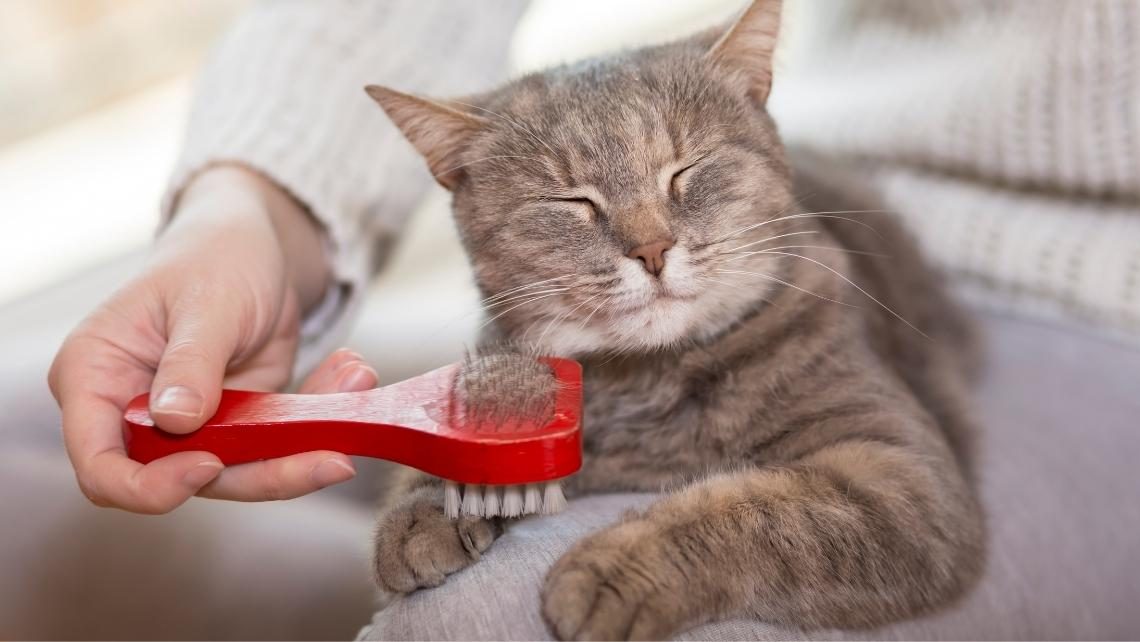Hair loss is one of the most common complaints reported by families with pets. The “problem” of hair loss is very common, both in dogs as well as in cats. But does hair loss always mean there’s a problem? Despite the unpleasantness of having to vacuum the house more often, in reality, hair loss can be perfectly normal in our pets. Other times, it means underlying disease.
Let’s explore some of the most common causes of hair loss and what we can do to address them:
1. Seasonal shedding
If your pet’s fur is shiny, dense and you don’t see localised hair loss, your pet’s skin and coat is most likely healthy. So why do they shed get so much fur?
At certain times of the year, it’s normal to have some hair loss in order for the coat to renew itself. The hair follicle simply ages and falls out, giving way to new fur in its place. This change of coat can be more frequent when temperatures rise, especially in breeds with an abundant undercoat.
Some breeds of dogs with a dense undercoat (e.g. Siberian Husky or German Spitz) have increased hair loss around spring and autumn. At these times, it is common to see an increase in the amount of hair around the house. The solution is to brush your pet frequently to remove loose hair or book a professional grooming service to get the job done. Bare in mind you’ll have to do this more than once, as hair will continue to fall out over time.
2. External Parasites
Hair loss can be due to excessive scratching and grooming. And nothing is itchier than external parasites. There are many external parasites our pets can pick up. Fleas are at the top of the list of these parasites in both dogs and cats, even strictly indoor cats. Be aware that while some external parasites are very visible, such as fleas and ticks, others are more difficult to observe, such as lice and mites. If you notice that your pet is scratching more than usual, use your regular external parasite preventative. Ideally, you should consult your veterinarian to diagnose the parasite that is present and the most appropriate treatment.

3. Skin infections (dermatitis)
The skin is an organ inhabited by bacteria and fungi that, in normal situations, don’t cause any kind of problem. However, there are numerous situations that lead to an imbalance of your pet’s skin’s flora. When imbalances occur and one or more of these micro-organisms cause infection, we call it a dermatitis. Depending on the type of microorganism, the visible signs of dermatitis can be different and its treatment is also different. In addition to treating the dermatitis, it may be necessary to find out if there is a primary cause that needs to be addressed. Skin problems should be diagnosed by a veterinarian first. Treatment can be lengthy and require baths with topical solutions as well as appropriate oral or topical medication. Never attempt to treat your pet’s dermatitis without professional support. Not only can it make the problem worse, but it can also give rise to resistances, making the problem more difficult to solve later on.
4. Allergies
Our pets can suffer from allergies, just like us. Common dog and cat allergies include: flea bite allergy, food allergies, environmental allergies (e.g. dust mites, pollens or fungi). By their nature, allergies can cause itching, red and inflamed skin, constant licking, chronic otitis, among other signs. There are tests that veterinarians use to diagnose if our pets suffer from allergies. Ideally, treatment will not only improve the symptoms but remove or minimise the cause of the allergy from our pets’ lives. Keep in mind that a pet with allergies will require ongoing care throughout its life. Certain breeds or coat colours are more prone to allergic problems than others. You should find out more, if you can, before adopting a pet. Unfortunately, not wanting to deal with the inconvenience of having an allergic pet is a common cause of families giving up their pets, so try and find out as much as you can about pet allergies.
5. Other causes
Whenever your pet’s organism is in a situation of increased metabolic needs, hair loss can occur. Pregnancy, lactation, stress or malnutrition can cause hair loss or dull and brittle hair. Also, some hormonal diseases such as those related to the thyroid gland, adrenal glands or growth hormones have a visible effect on our pets’ coats. These conditions require blood tests to determine hormone levels in order to be correctly diagnosed and treated. Call your vet if you notice symmetrical hair loss and other signs that your pet is not normal (e.g., increased water intake, vomiting and diarrhea, among others). Cats, by nature, will stop grooming themselves when they’re ill and this may show on their coats. It is a very visible indicator that something is not right.
Don’t neglect the state of your dog or cat’s coat. Healthy animals have shiny, dense coats, with no bald patches. The state of the skin and coat are great indicators of you pet’s health, so you should keep an eye out for any changes.
You can always use the PETABLE App to keep track of your pet’s coat condition (with the ‘Photos/Notes’ function). Available on iOS and Android.

Leave a Comment